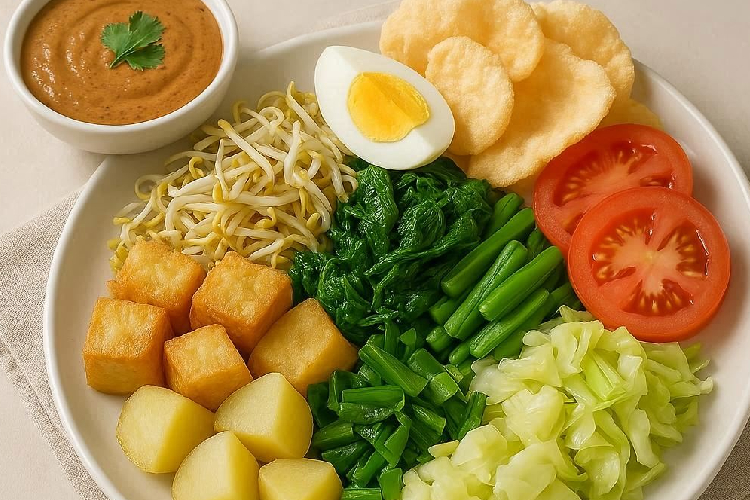TIMES MALAYSIA, JAKARTA – Among the many Indonesian dishes, gado-gado is always a familiar treat for the taste buds. A plate of gado-gado is usually full of colors: green from long beans, white from cabbage, orange from carrots, and yellow from potatoes and eggs.
All of these ingredients are combined with a thick, savory peanut sauce, making gado-gado not only filling but also enjoyable to eat.
Gado-gado is known to have originated from the Betawi community in Jakarta. Initially, this dish was served simply as a mixture of vegetables with peanut sauce.
Over time, additional ingredients such as rice cakes, tofu, tempeh, and crackers were added to increase the variety of flavors. Despite its simplicity, gado-gado has managed to survive as an everyday food that is easy to find, both at street stalls and restaurants.
The Contents
In addition to being delicious, gado-gado also has health benefits. According to Dr. Andreas Wilson Setiawan, M.Kes., through HelloSehat, one serving of gado-gado with lontong contains about 396 calories, while without lontong it is only about 266 calories.
This number is relatively low compared to the daily calorie requirements for adults. The fiber content from vegetables and plant-based protein from nuts, tofu, and tempeh make gado-gado a nutritious and balanced meal option.
Low-calorie foods like gado-gado are beneficial for maintaining weight, aiding digestion, and supporting a healthy lifestyle. Controlled calorie intake can also reduce the risk of obesity and metabolic diseases.
With its adjustable composition—for example, reducing the lontong or crackers—gado-gado is flexible for various dietary needs without losing its deliciousness.
Well Acknowleged by the World
Beyond its role as a nutritious meal, gado-gado has also gained international recognition as one of Indonesia’s culinary icons. Many Indonesian restaurants abroad feature gado-gado on their menus, introducing foreigners to the unique combination of fresh vegetables and peanut sauce.
In culinary festivals, this dish often becomes a highlight because it represents both simplicity and richness at the same time. The balance of taste, texture, and nutritional value makes it appealing to a wide audience across cultures.
Vegan Base
Interestingly, gado-gado can also be adapted to modern culinary trends. In Bali, Warung Pande in Canggu has become one of the pioneers in serving vegan gado-gado, offering a 100% plant-based version without eggs or animal products while keeping the dish flavorful and healthy.
Abroad, Wajan Indonesian Restaurant in Portland, Oregon, also provides a vegan option upon request, replacing eggs and other animal ingredients with plant-based alternatives while maintaining its authentic taste. These innovations show that gado-gado is not only a traditional dish but also a flexible one that continues to evolve with time.
More than just food, gado-gado also reflects a philosophy of togetherness. The mixture of various vegetables with different flavors and shapes blends into a harmonious dish, as if depicting the diversity of Indonesian society. In a plate of gado-gado, there is a story about tradition, health, and the simple but meaningful value of togetherness. (*)
Artikel ini sebelumnya sudah tayang di TIMES Indonesia dengan judul: Gado-Gado, Low Carbs Indonesian Salad for Your Healthy Diet
| Writer | : Khodijah Siti |
| Editor | : Khodijah Siti |

























